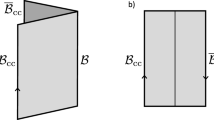Abstract
An analysis is presented of the significance and consequent limitations on the applicability of the von Neumann measurement postulate in quantum mechanics. Directly observable quantities, such as the expectation value of the velocity operator, are distinguished from mathematical constructs, such as the expectation value of the canonical momentum, which are not directly observable. A simple criterion to distinguish between the two types of operators is derived. The non-observability of the electromagnetic four-potentials is shown to imply the non-measurability of the canonical momentum. The concept of a mechanical gauge is introduced and discussed. Classically the Lagrangian is nonunique within a total time derivative. This may be interpreted as the freedom of choosing a “mechanical” (M) gauge function. In quantum mechanics it is often implicitly assumed that the M-gauge vanishes. However, the requirement that directly observable quantities be independent of the arbitrary mechanical gauge is shown to lead to results analogous to those derived from the requirement of electromagnetic gauge independence of observables. The significance of the above to the observability of transition amplitudes between field-free energy eigenstates in the presence (and absence) of electromagnetic fields is discussed. E- and M-gauge independent transition amplitudes between field-free energy eigenstates in the absence of electromagnetic fields are defined. It is shown that, in general, such measurable amplitudes cannot be defined in the presence of externally applied time-dependent fields. Transition amplitudes in the presence of time-independent fields are discussed. The path dependence of previous derivations of E-gauge independent Hamiltonians and/or transition amplitudes in the presence of electromagnetic fields are related to the inherent M-gauge dependence of these quantities in the presence of such fields.
Similar content being viewed by others
References
John von Neumann,Mathematical Foundations of Quantum Mechanics (Princeton University Press, Princeton, 1955), Chaps. V and VI.
E. P. Wigner, inQuantum Theory of Measurement, J. A. Wheeler and W. H. Zurek, eds. (Princeton University Press, Princeton, New Jersey, 1983), p. 260.
“... The possibility of finding a mathematical expression for the outcome of the measurement of an operator obviously does not guarantee the possibility of such a measurement....” (Ibid.,, p. 275.)
“... To repeat, all this is theory and there is no mathematical guarantee that even a transition probability into an arbitrary state can be measured. In order to guarantee the possibility of such a measurement, one would have to describe a way to do it. The mathematical theory of measurement, as formulated first by von Neumann, but now generally accepted, ingenious as it is, does not do that....” (Ibid.,, p. 276.)
See also the discussion of the theorem that: “... only quantities which commute with all additive conserved quantities are precisely measurable” (ibid., E. P. Wigner, inQuantum Theory of Measurement, J. A. Wheeler and W. H. Zurek, eds. (Princeton University Press, Princeton, New Jersey, 1983), p. 293) and of super selection rules (ibid., E. P. Wigner, inQuantum Theory of Measurement, J. A. Wheeler and W. H. Zurek, eds. (Princeton University Press, Princeton, New Jersey, 1983), p. 305).
H. Goldstein,Classical Mechanics (Addison-Wesley, Reading, Massachusetts, 1980), 2nd edn.
T. E. Feuchtwang, K. Kazes, H. Grotch, and P. H. Cutler,J. Phys. A 17, 151 (1984).
Y. Aharonov and D. Bohm,Phys. Rev. 125, 2192 (1962).
F. J. Belinfante,Phys. Rev. 128, 2832 (1962).
B. S. DeWitt,Phys. Rev. 125, 2189 (1962).
S. Mandelstam,Ann. Phys. (New York) 19, 1 (1962).
E. Kazes, T. E. Feuchtwang, P. H. Cutler, and H. Grotch,Phys. Rev. D 27, 1388 (1983).
T. E. Feuchtwang, E. Kazes, H. Grotch, and P. H. Cutler,Phys. Lett. A 93, 4 (1982).
C. Cohen-Tannoudji, B. Diu, and F. Laloe,Quantum Mechanics (Hermann, Paris; Wiley, New York, 1977), Vol. 1, p. 315.
K. H. Yang,J. Phys. A Math. Gen. 15, 437, 1201 (1982).
K. H. Yang,J. Phys. A Math. Gen. 16, 919, 935 (1983).
T. E. Feuchtwang, E. Kazes, and P. H. Cutler,J. Phys. A 17, 1157 (1984).
Y. Aharonov and C. K. Au,Phys. Rev. B 20, 1553 (1974).
K. Haller and L. F. Landowitz,Phys. Rev. D 2, 1498 (1970).
K. Haller,Acta Phys. Aust. 42, 163 (1975).
K. Haller and S. B. Sohn,Phys. Rev. A 20, 1541 (1979).
K. Haller and R. G. Brickner,Nuovo Cimento A 73, 117 (1983).
E. Kazes, T. E. Feuchtang, P. H. Cutler, and H. Grotch,Ann. Phys. (New York) 142, 80 (1982).
J. R. Taylor,Scattering Theory (Wiley, New York, 1972), Chap. 10.
C. K. Au,J. Phys. B At. Mol. Phys. 17, L59 (1984).
W. E. Lamb, Jr.,Phys. Today 19, 1 (1969).
Author information
Authors and Affiliations
Rights and permissions
About this article
Cite this article
Feuchtwang, T.E., Kazes, E. & Cutler, P.H. Generalized gauge independence and the physical limitations on the von Neumann measurement postulate. Found Phys 16, 1263–1284 (1986). https://doi.org/10.1007/BF00732120
Received:
Revised:
Issue Date:
DOI: https://doi.org/10.1007/BF00732120




